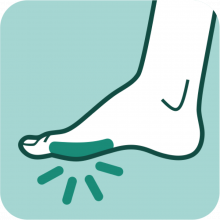Wart
What is a wart?
Warts (verrucae vulgaris) are benign, cauliflower-shaped outgrowths of skin. A foot wart is contagious and can occur because your foot came into contact with the humane papilloma virus. The odds of contagion are similar to foot fungus (please also see our topics nail fungus or skin fungus). Risk of infection is highest in spaces where multiple people walk around barefoot, such as sports facilities, public swimming pools, communal showers and sauna facilities. Of course, infection may also occur at other locations.
Description foot wart
An ordinary foot wart is a cauliflower-shaped outgrowth of skin. On the sole of the foot, the weight of the body has pressed warts inward and flattened them. Just like warts on other body parts, foot warts are caused by a viral disease. Warts on or under your feet are often pressured by your body, which can result in pain. There are two types of foot warts: the mosaic wart and the plantar wart. Depending on the type, they can expand on the surface or deeper into the skin. Both are flat in shape and roughly have a cauliflower-shaped structure. Foot warts most commonly occur in the callused area around the sole, but they can also occur at other places on your foot. Foot warts are highly contagious. Most warts disappear by themselves after some time. In other words, having your wart removed is not always necessary. However, if the warts cause pain or discomfort, we do recommend treatment.
Foot wart or corn? The two are often hard to distinguish. The difference between a wart and a corn is that a wart hurts with sideways pressure, while a corn hurts when pressed from above. In addition, a wart under your foot hurts differently when walking. A wart often hurts when pushing off, while a corn hurts when you stand on it. A wart is shaped more like a cauliflower whereas a corn has a shiny callus structure.
Symptoms of a wart
Where do foot warts come from?
You can contract a wart under your foot through a virus that you may have gotten in the swimming pool, a gym or when trying on shoes barefoot. There is an especially high risk of infection in popular public places, where the virus has the chance to develop due to the warm and humid environment.
What you can do to prevent warts
To prevent warts, we recommend not walking barefoot in public spaces such as swimming pools, saunas, dressing rooms and gyms. Wear slippers or other footwear. Always carefully dry your feet, including between the toes. Do not share your shoes or slippers with others. Do not share towels and wash your towels at at least 60 degrees Celsius. Wear socks when trying on new shoes. Never scratch warts; the top layer is especially contagious. A general tip is to put a bandage over the wart. Do you have a foot wart? Please make sure to properly wash and dry your hands after touching it.
Treating warts
If you have or think you have a foot wart, then we advise you to contact your general practitioner. The GP can remove your wart by freezing it with liquid nitrogen. However, this does not eradicate the virus. In other words, warts may return. In addition, the treatment may be painful. The GP can refer you to a pedicurist or medical pedicurist. They can treat your wart pain-free. Pedicurists and medical pedicurists affiliated with branch organisation ProVoet are trained to treat your feet so the foot warts are not only removed, but also decrease the likelihood of them returning in the future. In addition, the medical pedicurist can free the foot wart of pressure in case of pain. Do you have at-risk feet? These are feet with a heightened risk at complications due to a certain illness, such as diabetes mellitus, a rheumatic condition, psoriasis, cancer or an elderly foot. If so, please schedule an appointment with a medical pedicurist for the treatment of your foot wart.
